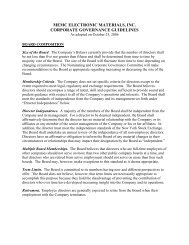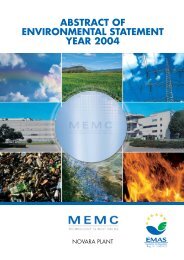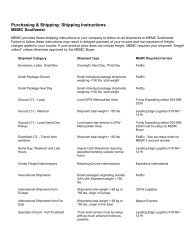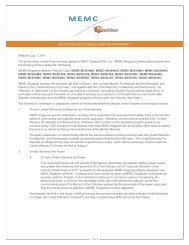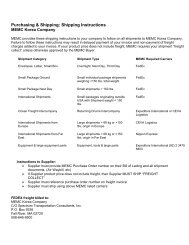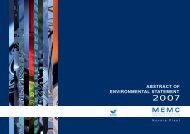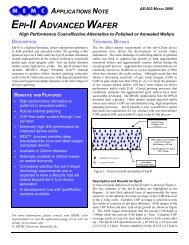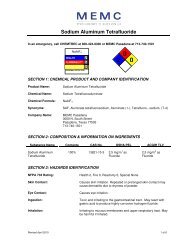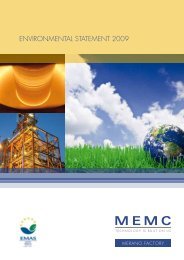Silane - MEMC Electronic Materials, Inc.
Silane - MEMC Electronic Materials, Inc.
Silane - MEMC Electronic Materials, Inc.
Create successful ePaper yourself
Turn your PDF publications into a flip-book with our unique Google optimized e-Paper software.
<strong>Silane</strong>In an emergency, call CHEMTREC at 800-424-9300 or <strong>MEMC</strong> Pasadena at 713-740-1501<strong>Silane</strong>24240SECTION 1: CHEMICAL PRODUCT AND COMPANY IDENTIFICATIONProduct Name:Chemical Name:Chemical Formula:Synonyms:Company Name:<strong>Silane</strong>Silicon TetrahydrideH 4 SiMonosilane, Silicane, Silicon Tetrahydride<strong>MEMC</strong> Pasadena3000 N. South StreetPasadena, Texas 77503713-740-1501SECTION 2: COMPOSITION & INFORMATION ON INGREDIENTSSubstance Name Contents CAS No. OSHA PEL ACGIH TLVSilicon Tetrahydride 100% 7803-62-5 Not established 5 ppmSECTION 3: HAZARDS IDENTIFICATIONNFPA 704 Rating:Eye Contact:Health 2, Fire 4, Reactivity 0, Special NoneExpected to be an eye irritant.Revised April 2010 1 of 6
<strong>Silane</strong>SECTION 4: FIRST AID MEASURESInhalation:Remove to fresh air. If breathing is difficult, give oxygenand seek medical attention.Eye Contact: Flush with copious amounts of water for at least 15minutes. If irritation persists, seek medical attention.Skin Contact:Ingestion:Remove contaminated clothing. Immediately flush skinwith plenty of water for at least 15 minutes. Get medicalattention promptly.If swallowed, drink as much water as possible. Do notinduce vomiting. Get medical attention.SECTION 5: FIRE FIGHTING MEASURESFlammability Classification(Per 49 CFR Part 173 Subpart D):Known or Anticipated HazardousProducts of Combustion:Extinguishing Media:Fire Fighting Instructions:Unusual Fire And ExplosionHazards:2.1 (Flammable Gas)<strong>Inc</strong>ludes amorphous silica dustNot applicable. Use water spray or fog to cool exposedequipment and containers. Do not breathe smoke orvapors.Evacuate all personnel from danger area. Do notapproach area without self-contained breathing apparatusand protective clothing. Immediately cool containers withwater spray from maximum distance. Stop flow of gas, ifwithout risk, while continuing cooling water spray. If flowof gas can not be shut off, allow fire to burn out. Reducecombustion products with water spray or fog. Remove allcontainers from area of fire, if without risk.Pyrophoric gas (may ignite spontaneously in air eitherimmediately or delayed). Containers may rupture due toheat of fire. Containers should not be subjected to atemperature higher than 52°C/126°F. Backflow intocylinder may cause explosion. Most containers areprovided with a pressure relief device designed to ventcontainer contents when they are exposed to elevatedtemperature.Revised April 2010 2 of 6
<strong>Silane</strong>SECTION 6: ACCIDENTAL RELEASE MEASURESPersonnel Protection:Environmental Protection:Avoid skin contact. Do not inhale vapors. Evacuateimmediate areas as necessary. Use NIOSH-approveddust, fume, mist respirator. Ensure adequate ventilation.Keep unprotected personnel away.Take precautions to ensure material does not contaminatethe ground or enter the drainage system.SECTION 7: HANDLING AND STORAGEHandling:Storage:Avoid contact with eyes, skin and clothing. Keepcontainers tightly sealed.Store in cool, dry, well-ventilated area. Close valve oncontainer when not in use.See Section 16 Additional Precautions for additionalhazard information.SECTION 8: EXPOSURE CONTROL/PERSONAL PROTECTIONVentilation and Engineering Controls:Respiratory Protection:Eye Protection:Hand Protection:General Hygiene Measures:Use local exhaust ventilation.Use NIOSH (U.S.) or CEN (EU) approved dust, fume, mistrespirator for combustion or decomposition products.Chemical goggles and the aluminized hood of a proximitysuit. Use goggles and face shield for small-scalelaboratory operation.Use loose-fitting aluminized or leather gloves.Keep away from foodstuffs, beverages and feed. Removeall soiled/contaminated clothing immediately. Wash handsbefore breaks and at the end of work. Avoid contact witheyes and skin.SECTION 9: PHYSICAL AND CHEMICAL PROPERTIESAppearanceColorless gasOdor:Repulsive, choking odorpH:Not applicableSublimation Temperature (at 1 atm): UnknownSolubility in Water:Reacts with waterMelting Point:-185°CBoiling Point:-112°CSpecific gravity/Density:0.7 g/ml (liquid), 1.342 kg/m 3 (gas)Vapor Pressure: Gas at 20°CVapor Density:1.2 (Air=1)Revised April 2010 3 of 6
<strong>Silane</strong>SECTION 9: PHYSICAL AND CHEMICAL PROPERTIES (continued)Flammability:Flash Point:Flammability Limits in Air:Auto Ignition temperature:SECTION 10: STABILITY AND REACTIVITYUnknownPyrophoric gasLEL=1.4% UEL=96%21°C (70°F)Chemical Stability:Conditions to Avoid:<strong>Inc</strong>ompatibility with Other <strong>Materials</strong>:Hazardous Decomposition, ReactionAnd Oxidation (other than burning)Products:Hazardous Polymerization:UnstableCylinder temperature should not exceed 52°C (126°F)Air, water, solutions of bases, oxidizing agents, halogensAmorphous silica dust.Will not occur.SECTION 11: TOXICOLOGICAL INFORMATIONRTECS Number:Acute Toxicity:Chronic and Subchronic Data:Special Studies:Suspected cancer agent:Irritancy of product:Sensitization of product:Reproductive toxicityinformation:Mutagenicity:Embryotoxicity:Teratogenicity:Reproductive Toxicity:VV1400000UnknownInhalation LC 50 (rat)>9,600 ppm (4 hours)Dermal LD 50 (rabbit)=3,540 mg/kgNone known to <strong>MEMC</strong> Pasadena, <strong>Inc</strong>.<strong>Silane</strong> is not found on the following lists: FEDERAL OSHA ZLIST, IARC, NTP, and California and therefore is neitherconsidered to be nor suspected to be a cancer-causing agent bythese agencies.<strong>Silane</strong> is expected to be irritating to respiratory system.<strong>Silane</strong> is not known to be a sensitizer to humans uponprolonged or repeated contact.Listed below is information concerning the effects of <strong>Silane</strong> onthe human reproductive system.No human mutagenic effects have been described for <strong>Silane</strong>.No human embryotoxic effects have been described for <strong>Silane</strong>.No human teratogenic effects have been described for <strong>Silane</strong>.No human reproductive effects have been described for <strong>Silane</strong>.Revised April 2010 4 of 6
<strong>Silane</strong>SECTION 12: ECOLOGICAL INFORMATIONEcological Effects:Take care to prevent material from entering the ground, watercourses or drainage systems.SECTION 13: DISPOSAL CONSIDERATIONSConsult local, state or national regulations to endure proper disposal.SECTION 14: TRANSPORTATION INFORMATIONDOT Description/Shipping Name:DOT Hazard Class:DOT ID Number:<strong>Silane</strong>2.1 (Flammable Gas)UN2203SECTION 15: REGULATORY INFORMATIONADDITIONAL U.S. REGULATIONS:U.S. Sara Reporting Requirements: Silicon Tetrahydride is subject to the reporting requirements ofSections 302, 304, and 313 of Title III of the Superfund Amendments and Reauthorization Act, asfollows:CHEMICAL NAME SARA 302 SARA 304 SARA 313(40 CFR 355, Appendix A) (40 CFR Table 302.4) (40 CFR 372.65)Silicon Tetrahydride No No NoU.S. SARA Threshold Planning Quantity: Not applicable.U.S. CERCLA Reportable Quantity (RQ): Not applicable.U.S. TSCA Inventory Status: Silicon Tetrahydride is listed on the TSCA Inventory.Other U.S. Federal Regulations: Silicon Tetrahydride is not subject to the reporting requirements ofCFR 29 1910.1000.California Safe Drinking Water and Toxic Enforcement Act (Proposition 65): Silicon Tetrahydrideis not on the California Proposition 65 lists.Pennsylvania Right To Know: Silicon Tetrahydride – YesNew Jersey Right To Know: Silicon Tetrahydride – YesCanadian Regulatory Information: This product has been classified in accordance with the hazardcriteria of the CPR, and the MSDS contains all the information required by the CPR.DSL – No, NDSL – Yes.EU Risk Phrases:R17-36/37/38S3/9/49Spontaneously flammable in air. Irritating to eyes, respiratory systemand skin.Keep only in the original container in a cool, well-ventilated place.Revised April 2010 5 of 6
<strong>Silane</strong>SECTION 16: OTHER INFORMATIONADDITIONAL PRECAUTIONS OR COMMENTSFlammable, pyrophoric, high pressure gas (may ignite spontaneously in air, either immediately ordelayed). May form an explosive mixture with air. Does not need a source of ignition. Use piping andequipment adequately designed to withstand pressures to be encountered. Use only in a closedsystem purged with an inert gas prior to discharge from cylinder. Backflow into a cylinder may causean explosion. Use a check valve or protection apparatus in any line or piping from the cylinder toprevent backflow.Disclaimer<strong>MEMC</strong> Pasadena, <strong>Inc</strong>. cannot guarantee that these are the only hazards that exist. Users are solelyresponsible for the safe storage, handling, use and disposal of this material, and for compliance withthe applicable laws, regulations and accepted practices. <strong>MEMC</strong> Pasadena, <strong>Inc</strong>. makes norepresentations or warranties; either expressed or implied, of merchantability, fitness for a particularpurpose, or any other nature.Revised April 2010 6 of 6



